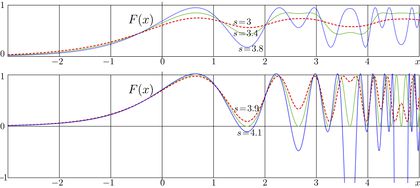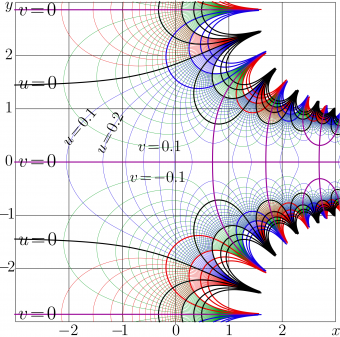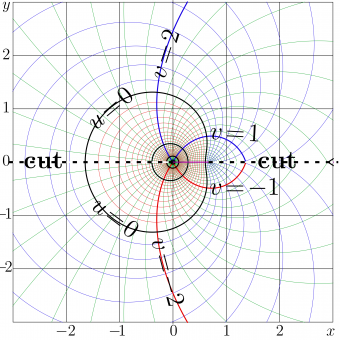Difference between revisions of "LogisticSequence"
m (Text replacement - "\$([^\$]+)\$" to "\\(\1\\)") |
|||
| (One intermediate revision by one other user not shown) | |||
| Line 1: | Line 1: | ||
| − | [[File:Logi5T1500.png|360px|thumb| |
+ | <!--[[File:Logi5T1500.png|360px|thumb|\(F(x)=\mathrm{LogisticSequence}_s(x)\) versus \(x\) for \(s\!=\!3\), \(s\!=\!3.4\), \(s\!=\!3.8\)]] |
| − | [[File:Logi5U1500.png|360px|thumb| |
+ | [[File:Logi5U1500.png|360px|thumb|\(F(x)=\mathrm{LogisticSequence}_s(x)\) versus \(x\) for \(s\!=\!3.9\), \(s\!=\!4\), \(s\!=\!4.1\)]] !--> |
| + | [[File:LogisticSecK2.jpg|420px|thumb|\(F(x)=\) LogisticSequence\(_s(x)~\) versus \(x\) for \(~s\!=\!3~\), \(~s\!=\!3.4~\), \(~s\!=\!3.8~\) and for \(~s\!=\!3.9~\), \(~s\!=\!4~\), \(~s\!=\!4.1~\)]] |
||
| ⚫ | |||
| − | [[File: |
+ | [[File:Logi2c3T1000.png|340px|thumb|\(u\!+\! \mathrm i v =\) LogisticSequence\(_3(x\!+\!\mathrm i y)\)]] |
| ⚫ | |||
[[LogisticSequence]] (without spacebar between words) is |
[[LogisticSequence]] (without spacebar between words) is |
||
specific [[superfunction]] of the special case of quadratic [[transfer function]] called [[Logistic]] function or [[LogisticOperator]] |
specific [[superfunction]] of the special case of quadratic [[transfer function]] called [[Logistic]] function or [[LogisticOperator]] |
||
| − | : |
+ | : \(\!\!\!\!\!\!\!\!\!\!\!(1) ~ ~ ~ ~ \mathrm{LogisticOperator}_s(z) = s\,z \,(1\!-\!z)\) |
| − | where |
+ | where \(z\) is complex number and \(s\) is real number; usually it is assumed that \(s>1\). |
| − | For various values of |
+ | For various values of \(s\), the explicit plots of LogisticSequence are shown in two figures at right. Below, the [[complex map]]s of function \(\mathrm{LogisticSequence}_s\) are shown for \(s\!=\!3\) and for \(s\!=\!4\). |
==About the name== |
==About the name== |
||
| Line 17: | Line 18: | ||
For this reason, in [[TORI]], the name [[LogisticSequence]] is reserved for namely this specific function. Other [[superfunction]]s of the [[logistic]] operator should have other names. At least, for other superfunctions of the logistic operator, the words [[Logistic Sequence]] should not be written together without spacebar. |
For this reason, in [[TORI]], the name [[LogisticSequence]] is reserved for namely this specific function. Other [[superfunction]]s of the [[logistic]] operator should have other names. At least, for other superfunctions of the logistic operator, the words [[Logistic Sequence]] should not be written together without spacebar. |
||
| − | However, the same names can be used for cases of complex |
+ | However, the same names can be used for cases of complex \(s\) or for |
any other more complicated objects as parameter and argument of the [[LogisticOperator]], assuming that the operations of multiplication and substraction in (1) for these objects are somehow defined. |
any other more complicated objects as parameter and argument of the [[LogisticOperator]], assuming that the operations of multiplication and substraction in (1) for these objects are somehow defined. |
||
| Line 23: | Line 24: | ||
The definition below is based on the article [[Logistic sequence]] and links cited there, in particular, the [[Holomorphic extension of the logistic sequence]]. |
The definition below is based on the article [[Logistic sequence]] and links cited there, in particular, the [[Holomorphic extension of the logistic sequence]]. |
||
| − | [[LogisticSequence]] is function of complex argument (denoted below as |
+ | [[LogisticSequence]] is function of complex argument (denoted below as \(z\)) with single real parameter (denoted below as \(s\)) is solution \(F\) |
of the [[Transfer equation]] |
of the [[Transfer equation]] |
||
| − | : |
+ | : \(\!\!\!\!\!\!\!\!\!\!\!(2) ~ ~ ~ ~ F(z\!+\!1) = T(F(z))\) |
| − | for the [[transfer function]] |
+ | for the [[transfer function]] \(T=\mathrm{LogisticOperator}_s\) by equation (1) |
| − | with the following asymptotic behavior at |
+ | with the following asymptotic behavior at \(\Re(z) \rightarrow - \infty\): |
| − | : |
+ | : \(\!\!\!\!\!\!\!\!\!\!\!(3) ~ ~ ~ ~ F(z) = s^z + O(s^{2z})\) |
While no mathematical proof of uniqueness is available, it should be assumed that the function with asymptotic (3) is constructed by method of [[regular iteration]]. |
While no mathematical proof of uniqueness is available, it should be assumed that the function with asymptotic (3) is constructed by method of [[regular iteration]]. |
||
| Line 36: | Line 37: | ||
The LogisticSequence is entire function, it has no singularities in the whole complex plane. |
The LogisticSequence is entire function, it has no singularities in the whole complex plane. |
||
| − | LogisticSequence is periodic function; the period |
+ | LogisticSequence is periodic function; the period \(P\) is pure imaginary |
| − | : |
+ | : \(\!\!\!\!\!\!\!\!\!\!\!(4) ~ ~ ~ ~\displaystyle P=\frac{2\, \pi\, \mathrm i}{\ln(s)}\) |
| − | For the specific case |
+ | For the specific case \(s=4\), the LogisticSequence and its inverse functions can be expressed in terms of [[elementary functions]], |
| − | : |
+ | : \(\!\!\!\!\!\!\!\!\!\!\!(5) ~ ~ ~ ~\displaystyle \mathrm{LogisticSequence}_4(z) = \frac{1}{2}\big(1-\cos(2^z)\big)\) |
| − | : |
+ | : \(\!\!\!\!\!\!\!\!\!\!\!(6) ~ ~ ~ ~\displaystyle \mathrm{ArcLogisticSequence}_4(z) =\log_2\big(\arccos(1-2z)\big)\) |
==Logistic sequence== |
==Logistic sequence== |
||
| − | [[File:Logi2d3T1500.png|340px|thumb| |
+ | [[File:Logi2d3T1500.png|340px|thumb| \(u\!+\!\mathrm i v= \)ArcLogisticSequence\(_3(x\!+\!\mathrm i y)\)]] |
| − | In literature, the words [[Logistic sequence]] may refer to any infinite [[sequence]] of [[number]]s |
+ | In literature, the words [[Logistic sequence]] may refer to any infinite [[sequence]] of [[number]]s \(f_n\), such that |
| − | : |
+ | : \(\!\!\!\!\!\!\!\!\!\!\!(7) ~ ~ ~ ~ f_{n+1}=\mathrm{LogisticOperator}_s(f_n)\) |
| − | for some real |
+ | for some real \(s\) and some \(f_0\). Usually, it is assumed that \(f_0\) is also real. |
| − | The elements of such sequence |
+ | The elements of such sequence \(f\) can be written as |
| − | : |
+ | : \(\!\!\!\!\!\!\!\!\!\!\!(8) ~ ~ ~ ~ f_n=\mathrm{LogisticSequence}_s(z_0+n)\) |
| − | where real number |
+ | where real number \(z_0\) is solution of equation |
| − | : |
+ | : \(\!\!\!\!\!\!\!\!\!\!\!(9) ~ ~ ~ ~ \mathrm{LogisticSequence}_s(z_0)=f_0\) |
| − | Parameter |
+ | Parameter \(z_0\) can be expressed through the inverse function of the LogisticSequence, |
| − | : |
+ | : \(\!\!\!\!\!\!\!\!\!\!\!\!\!\!\!(10) ~ ~ ~ ~ z_0=\mathrm{ArcLogisticSequence}_s(f_0)\) |
| − | Properties of holomorphic function [[ArcLogisticSequence]] are also known. As an example, the [[complex map]] of function [[ArcLogisticSequence]] |
+ | Properties of holomorphic function [[ArcLogisticSequence]] are also known. As an example, the [[complex map]] of function [[ArcLogisticSequence]]\(_3\) is shown in figure at right. With the generator supplied, the similar maps can be plotted for other values of the parameter. For generation of various logistic sequences, that begin with a real number, values of function [[ArcLogisticSequence]] along the real axis are necessary; in the figure, these values correspond to the pink line \(v\!=\!0\) at the real axis between 0 and 3/4. |
==Evaluation of the LogisticSequence and the Numerical implementation== |
==Evaluation of the LogisticSequence and the Numerical implementation== |
||
| Line 69: | Line 70: | ||
in [[real time]]. |
in [[real time]]. |
||
| − | The numerical implementations with 14 decimal digits in [[C++]] for functions |
+ | The numerical implementations with 14 decimal digits in [[C++]] for functions \(\mathrm {LogisticSequence}_s\) and \(\mathrm {ArcLogisticSequence}_s\) are available. The complex maps of these functions for various \(s\) are suggested in <ref name="logi"> |
http://tori.ils.uec.ac.jp/PAPERS/2010logistie.pdf |
http://tori.ils.uec.ac.jp/PAPERS/2010logistie.pdf |
||
D.Kouznetsov. Holomorphic extension of the logistic sequence. Moscow University Physics Bulletin, 2010, No.2, p.91-98. (Russian version: p.24-31) |
D.Kouznetsov. Holomorphic extension of the logistic sequence. Moscow University Physics Bulletin, 2010, No.2, p.91-98. (Russian version: p.24-31) |
||
| Line 82: | Line 83: | ||
[[Category:Logistic Sequence]] |
[[Category:Logistic Sequence]] |
||
| + | [[Category:LogisticSequence]] |
||
[[Category:Superfunction]], |
[[Category:Superfunction]], |
||
[[Category:Transfer function]] |
[[Category:Transfer function]] |
||
Latest revision as of 18:26, 30 July 2019
LogisticSequence (without spacebar between words) is specific superfunction of the special case of quadratic transfer function called Logistic function or LogisticOperator
- \(\!\!\!\!\!\!\!\!\!\!\!(1) ~ ~ ~ ~ \mathrm{LogisticOperator}_s(z) = s\,z \,(1\!-\!z)\)
where \(z\) is complex number and \(s\) is real number; usually it is assumed that \(s>1\).
For various values of \(s\), the explicit plots of LogisticSequence are shown in two figures at right. Below, the complex maps of function \(\mathrm{LogisticSequence}_s\) are shown for \(s\!=\!3\) and for \(s\!=\!4\).
About the name
The names Logistic operator and logistic sequence were used by Pavel Elutin in the email corresponcence in year 2009, and since that, no other names no these function are suggested. In the mathematic notations (say, following the common sense), the spacebar between expressions, by default, is interpreted as operation of multiplication. For this reason, the name of the function is created from two words without space between them. Following the style of the Mathematica language, the second word is capitalized.
The LogisticSequence seems to be the most "natural" and most "physical" extension of the integer sequence considered in the literature; this extension appears at the construction of superfunction for the logistic transfer function by the method of regular iteration at the fixed point 0. For this reason, in TORI, the name LogisticSequence is reserved for namely this specific function. Other superfunctions of the logistic operator should have other names. At least, for other superfunctions of the logistic operator, the words Logistic Sequence should not be written together without spacebar.
However, the same names can be used for cases of complex \(s\) or for any other more complicated objects as parameter and argument of the LogisticOperator, assuming that the operations of multiplication and substraction in (1) for these objects are somehow defined.
Definition
The definition below is based on the article Logistic sequence and links cited there, in particular, the Holomorphic extension of the logistic sequence.
LogisticSequence is function of complex argument (denoted below as \(z\)) with single real parameter (denoted below as \(s\)) is solution \(F\) of the Transfer equation
- \(\!\!\!\!\!\!\!\!\!\!\!(2) ~ ~ ~ ~ F(z\!+\!1) = T(F(z))\)
for the transfer function \(T=\mathrm{LogisticOperator}_s\) by equation (1)
with the following asymptotic behavior at \(\Re(z) \rightarrow - \infty\):
- \(\!\!\!\!\!\!\!\!\!\!\!(3) ~ ~ ~ ~ F(z) = s^z + O(s^{2z})\)
While no mathematical proof of uniqueness is available, it should be assumed that the function with asymptotic (3) is constructed by method of regular iteration.
Properties of the LogisticSequence
The LogisticSequence is entire function, it has no singularities in the whole complex plane.
LogisticSequence is periodic function; the period \(P\) is pure imaginary
- \(\!\!\!\!\!\!\!\!\!\!\!(4) ~ ~ ~ ~\displaystyle P=\frac{2\, \pi\, \mathrm i}{\ln(s)}\)
For the specific case \(s=4\), the LogisticSequence and its inverse functions can be expressed in terms of elementary functions,
- \(\!\!\!\!\!\!\!\!\!\!\!(5) ~ ~ ~ ~\displaystyle \mathrm{LogisticSequence}_4(z) = \frac{1}{2}\big(1-\cos(2^z)\big)\)
- \(\!\!\!\!\!\!\!\!\!\!\!(6) ~ ~ ~ ~\displaystyle \mathrm{ArcLogisticSequence}_4(z) =\log_2\big(\arccos(1-2z)\big)\)
Logistic sequence
In literature, the words Logistic sequence may refer to any infinite sequence of numbers \(f_n\), such that
- \(\!\!\!\!\!\!\!\!\!\!\!(7) ~ ~ ~ ~ f_{n+1}=\mathrm{LogisticOperator}_s(f_n)\)
for some real \(s\) and some \(f_0\). Usually, it is assumed that \(f_0\) is also real.
The elements of such sequence \(f\) can be written as
- \(\!\!\!\!\!\!\!\!\!\!\!(8) ~ ~ ~ ~ f_n=\mathrm{LogisticSequence}_s(z_0+n)\)
where real number \(z_0\) is solution of equation
- \(\!\!\!\!\!\!\!\!\!\!\!(9) ~ ~ ~ ~ \mathrm{LogisticSequence}_s(z_0)=f_0\)
Parameter \(z_0\) can be expressed through the inverse function of the LogisticSequence,
- \(\!\!\!\!\!\!\!\!\!\!\!\!\!\!\!(10) ~ ~ ~ ~ z_0=\mathrm{ArcLogisticSequence}_s(f_0)\)
Properties of holomorphic function ArcLogisticSequence are also known. As an example, the complex map of function ArcLogisticSequence\(_3\) is shown in figure at right. With the generator supplied, the similar maps can be plotted for other values of the parameter. For generation of various logistic sequences, that begin with a real number, values of function ArcLogisticSequence along the real axis are necessary; in the figure, these values correspond to the pink line \(v\!=\!0\) at the real axis between 0 and 3/4.
Evaluation of the LogisticSequence and the Numerical implementation
For the precise evaluation of LogisticSequence and its inverse function, the Regular iteration can be used. With complex(double) arithmetics, of order of 14 decimal digits can be calculated with some tens of operations. This allows to plot the complex maps of the LogisticSequence in real time.
The numerical implementations with 14 decimal digits in C++ for functions \(\mathrm {LogisticSequence}_s\) and \(\mathrm {ArcLogisticSequence}_s\) are available. The complex maps of these functions for various \(s\) are suggested in [1].
References
- ↑ http://tori.ils.uec.ac.jp/PAPERS/2010logistie.pdf D.Kouznetsov. Holomorphic extension of the logistic sequence. Moscow University Physics Bulletin, 2010, No.2, p.91-98. (Russian version: p.24-31)



